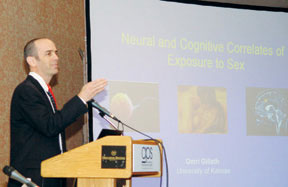What’s Love Got to Do With It?
All we need is love. Can’t help fallin’ in love. Can you feel the love tonight? I will always love you. And so forth.
Sure, it sells CDs (and books and flowers and movie tickets to cheesy romantic comedies), but really, what does love have to do with it? It turns out, romantic love may not always be our primary motivation when it comes to who we are attracted to and want to be with. This fascinating theme program at the APS 22nd Annual Convention brought together a number of researchers studying various aspects of love and sex.
We’ve all heard radio ads for pheromones, promising immediate popularity with just one spritz. Although most people think of sexual attraction when they hear the word “pheromone,” there are actually various forms of pheromones. Charles Wysocki from the Monell Chemical Senses Center described the different types of pheromones in humans, including how male odor signals have been shown to alter female neuroendocrine response and mood, and also that social odors may be more important for females than for males. In addition, there is evidence that gender and sexual orientation may influence perception of and response to body odor.

Charles J. Wysocki
It’s not surprising to learn that sex is everywhere: It plays an important role in close relationships, and we are constantly bombarded by sexy ads, trying to sell a variety of products (and not just pheromones!). What is surprising, observed Omri Gillath from the University of Kansas, is that although there has been a lot of research conducted on sex and sexuality, relatively little is known about the foundation of our sexual behavioral system. Gillath described his research on the ways that sexual stimuli can affect our mood, motivations, and how the brain responds to these stimuli. Subliminal exposure to sexual primes increased positive affect and motivation: Volunteers who were exposed to subliminal sexual primes were more motivated to continue working on a (boring) anagram task than were volunteers exposed to neutral primes. Neuroimaging data reveal that subliminal exposure to sexual cues resulted in higher activation of sex-related brain regions, whereas explicit exposure to sexual cues activated not only sex-related brain areas but also control-related areas, suggesting that sexual response/behavior may be based on the activation of two separate systems (arousal and control). This study also revealed an interesting difference in the way that men and women respond to sexual cues: Even during subliminal exposure to sexual cues, regions related to control were activated in women’s brains, suggesting that women may be more sensitive and have different reactions to sexual cues as compared with men.
Sex may make us happy and feel good, but how do we go about finding someone to have sex with? Romance and partner seeking is often construed as a competition — the mating game or a battle of the sexes. However, new findings by Joshua Ackerman from the Massachusetts Institute of Technology suggest that romantic cooperation does exist and may actually be common: Men help their male friends gain access to desired women while women help their female friends avoid undesirable men.
Once they have found a partner, there are 237 distinct reasons that women have sex — and love is only one of them, according to research by APS Fellow Cindy Meston of the University of Texas at Austin. There were lots of predictable reasons that made that list (such as sexual attraction and sexual pleasure), but there were a wealth of less predictable, and some outright surprising, reasons that women have sex, including competition, revenge, sexual economics (e.g., sex in exchange for a promotion, money or doing household chores), duty sex (to stop the partner from complaining about not getting enough sex), sex as a mate-guarding strategy to keep their partner from straying, sex for medicinal purposes (pain relief or to alleviate depression), sex to relieve boredom, and even sex as a means to get closer to God.

Omri Gillath
David Schmitt from Bradley University then switched the topic from sex to love, specifically ways in which our culture may determine the type of romantic attachment style and relationships we are drawn to. Schmitt found that non-Western cultures are likely to have more dismissing romantic attachment styles (those that are characterized by fear of intimacy and belief that they can only rely on themselves) than do Western cultures. Although men are generally more dismissing than women, this is not a universal finding. For example, in some African nations (e.g., Ethiopia, Botswana, and Tanzania) women are actually more dismissing than men. Dismissive relationship styles tend to be more common in cultures with high ecological stress (for example, low life expectancy or high infant mortality rate). In these cultures, where survival and prospects for future mates may be unreliable, insecure forms of attachment may be the more adaptive mating strategy.
For many people, the sex of the person they are sexually attracted to is the same as the sex of the person they are romantically attracted to. If this is not the case, an individual may identify themselves as bisexual. However, APS Fellow and Charter Member Daryl Bem of Cornell University argues this may not necessarily indicate bisexuality. Bem distinguished sexual attraction, which is attraction to a gender, from romantic attraction (love), which is attraction to an individual. He noted that research has suggested that women tend to fall in love first, and then have sexual desire toward an individual but in men, sexual desire tends to precede romantic attraction.





APS regularly opens certain online articles for discussion on our website. Effective February 2021, you must be a logged-in APS member to post comments. By posting a comment, you agree to our Community Guidelines and the display of your profile information, including your name and affiliation. Any opinions, findings, conclusions, or recommendations present in article comments are those of the writers and do not necessarily reflect the views of APS or the article’s author. For more information, please see our Community Guidelines.
Please login with your APS account to comment.